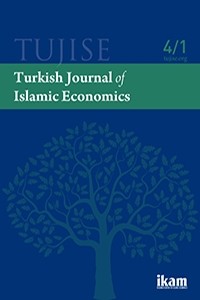İSLAMİ FİNANSAL GELİŞME VE İKTİSADİ BÜYÜME: TÜRKİYE İÇİN UYGULAMALI BİR ÇALIŞMA
Bu
çalışma Türkiye’de İslami finansal gelişmeyle iktisadi büyüme arasındaki bağı
araştırmaktadır. Çalışmada, VECM çerçevesi içinde ekonometrik birim kök,
eş-bütünleşme ve Granger nedensellik metodları kullanılmaktadır. Elde edilen
sonuçlara göre kısa ve uzun dönemde İslami finansal gelişmeden iktisadi
büyümeye doğru tek taraflı bir nedensellik vardır ve sonuçların hepsi İslami
finansal gelişme ölçümlerinin hepsi için güçlüdür. Dolayısıyla, politika karar
alıcıları Türkiye’de İslami finansal gelişimi daha fazla
desteklemelidirler.
Anahtar Kelimeler:
İslami finansal gelişme, Granger nedensellik, Türkiye
ISLAMIC FINANCE DEVELOPMENT AND ECONOMIC GROWTH: EMPIRICAL EVIDENCE FROM TURKEY
This
work is a study on Islamic finance development and economic growth nexus for
Turkey. It employs the econometric methods of unit root, co-integration, and
Granger causality in a VECM framework; and the results, which are robust to all
measures of Islamic finance development, show a unidirectional short and long
run causality from Islamic finance development to economic growth. Hence, it is
recommended that policy makers increase their efforts in promoting Islamic
finance in Turkey.
Keywords:
Islamic finance development, Granger causality, Turkey,
___
- AL-Oqool, Ali M, Reem O, and Bashayreh M. (2014). “Financial Islamic Banking Development and Economic Growth: A Case Study of Jordan.” International Journal of Economics and Finance 6(3):72–79. Retrieved (http://www.ccsenet.org/journal/index.php/ijef/article/view/33012).
- Asutay, M and Ergeç, E. H. (2013). “Financial Development and Economic Performance Nexus in the Case of Islamic and Conventional Banks in Turkey: An Empirical Analysis, 9th International Conference on Islamic Economics and Finance, September, Istanbul.
- Blackburn, Keith and Victor H, (1998), “A Theory of Growth, Financial Development and Trade. Economica, 65(.257):107-24.
- Dar. H (2013). Turkey’ S Potential Role as a Global Leader in Islamic Banking and Finance. Afro Eurasian Studies, Vol. 2, Issues 1&2, Spring & Fall 2013, 315-319
- De la Fuente, Angel and Jose M. M, (1996). Innovations, Bank Monitoring and Endogenous Financial Development. Journal of Monetary Economics, 38(2):269-301.
- Dickey, D.A. and Fuller, W.A. (1979). Distributions of the Estimators for AutoregressiveTime Series with a Unit Root. Journal of the American Statistical Association, 74, pp. 427-431.
- Engle, R. F., & Granger, C. W. J. (1987). Co-integration and Error Correction: Representation, Estimation and Testing. Econometrical, 55(2), 251–276. http://dx.doi.org/10.2307/1913236
- Friedman, M. and Schwartz, A.J. (1963). A Monetary History of the United States, Princeton University Press, Princeton.
- Furqani, H and Ratna M. (2009). Islamic Banking and Economic Growth: Empirical Evidence from Malaysia.” Journal of Economic Cooperation and Development 30(2):59–74.
- Goaied, M and Seifallah S. (2010). Financial Development and Economic Growth in the MENA Region: What about Islamic Banking Development. Institut des Hautes Etudes Commerciales, Carthage (January 2010):1–23.
- Halicioglu, F (2008). Financial Development Economic Growth Nexus for Turkey. Economics and Econometrics Research Institute Research Paper Series No 6.
- Imam, P. (2015). Is Islamic Banking Good for Growth? IMF Working Paper W15/81.
- Iqbal. Z (1997). Islamic Financial Systems. Finance & Development (June):p42–45.
- Katherine J (2013). The Role of Islamic Banking in Economic Growth. CMC Senior Theses Paper 642.
- Khoutem, B. J and B .N. (2012). Islamic Participative Financial Intermediation and Economic Growth. Journal of Islamic Economics, Banking and Finance 8(3).
- King and Levine (1993 Finance and Growth: Schumpeter Might be Right.Quarterly Journal of Economics, 108:3, pp. 717-737.
- Lucas, R. E. (1988). On the Mechanics of Economic Development. Journal of Monetary Economics, Vol. 22 PP. 3-42
- McCauley R. N, Zimmer, SA (1989). Explaining International Differences in the Cost of Capital: the U.S and U.K versus Japan and Germany. Federal Reserve Bank of New York Research Paper 8913..
- Giordano Dell-Amore (2015). Financial Deregulation In An Open Developing Economy: Lesson From The An Open Developing Financial Deregulation In Economy: Lesson From The Indonesia. Foundation Research Center on International Cooperation of the University of Bergamo 31(4):369–98.
- Patrick, H. (1966). Financial Development and Economic Growth in Underdeveloped Countries. Economic Development and Cultural Change, 174-189
- Pesaran, M.H., Shin, Y., and Smith, R.J. (2001). Bounds Testing Approaches to the Analysis of Level Relationships. Journal of Applied Econometrics, 16, pp. 289-326.
- Rajan, R., and L. Zingales, (1998). Financial Dependence and Growth. American Economic Review 88(3), 559-86.
- Robinson J (1979). The Generalisation of the General Theory, and Other Essays. London, MacMillan.
- Saleh S, M., Muhammad R, and Waqar A.( 2013). Does Islamic Banking System Contributes to Economy Development.. Global Journal of Management and Business Research 13(2).
- Schumpeter, J.A., orig. 1912, The Theory of Economic Development, trans. 1934 Harvard U.P., Cambridge, MA.
- Steffensen, J. (2013). Islamic Finance: Sources of Growth and Prospects for Global Development. National Bureau of Asian Research. Retrieved http://www.nbr.org/downloads/pdfs/eta/Vicary_interview_110713.pdf).
- Tabash, Mosab I. and Raj S. Dhankar. 2014. Financial Development and Economic Growth-- Empirical Evidence from United Arab Emirates. Journal of Emerging Economies and Islamic Research. Islamic 2(3).
- Tunay B. (2016). Causality Relations Between Islamic Banking and Economic Growth.Yonetim ve Ekonomi 23(2)
- Başlangıç: 2014
- Yayıncı: Research Center for Islamic Economics (ikam)
Sayıdaki Diğer Makaleler
Abidullah ABID, Muhammad Hakimi SHAFIAI
KATILIM BANKALARINDA PERFORMANSIN BİLEŞENLERİ; ÖZEL CARİ HESAPLARIN ROLÜ
İSLAMİ FİNANSAL GELİŞME VE İKTİSADİ BÜYÜME: TÜRKİYE İÇİN UYGULAMALI BİR ÇALIŞMA
Mustapha JOBARTEH, Etem Hakan ERGEC
KİTAP TANITIMI: İslam’ın Erken Döneminde Kapitalizmin Doğuşu
NİJERYA’DA İSLAMİ BANKACILIK VE İSLAM ALİMLERİ
MALEZYA VE TÜRKİYE’DEKİ VAKIFLARIN TOPLUMUN SOSYO-EKONOMİK KOŞULLARINA YAPTIĞI KATKILAR
Norma Md SAAD, Saim KAYADIBI, Zarinah HAMID
